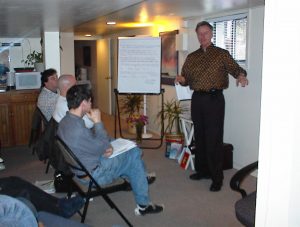 Mixing with Co-Trainers
Mixing with Co-Trainers
Years ago I developed training programs for Intel. It was my first opportunity to work with a Mentor who also had an educational focus in professional training, and my beginning with mixing and working with co-traininers.
Jeanie Wentworth and I met and discussed how to bring training to a higher level and one way we wanted to present material was with engineers, managers, technicians and leaders working together to give both sides of the process and experience.
Since our programs were being developed for “co-trainers” to present, she encouraged me to find some books that talked about how people worked together when they trained together, so we could add tips. Her suggestion led me on a search that elicited not a single resource back in 2001.
There were books about training, games in training, and many various topics, but nothing covered tips and tricks to help people to present together. Jeanie suggested that I put together a publication on what I had learned in my own experience and give our trainers the benefit of my tips and then she added her years of experience. It really made a difference. Unless you work at Intel you can’t access that document, but I can certainly share a small crop of ideas to grow your experience.
Cat Wilson’s Co-Trainer Tips
- Meet ahead of time and agree on the objectives of the course.
- Be clear in who presents each learning process and what will be covered.
- Time your training, and use a timing device that both people agree to stick to. When it goes off, the sound is sufficient. Setting it for a 5-minute question period is good for class.
- Make time for stories. Present a situation where the training was useful and turn to your co-trainer and ask for their story. Be sure that you are both in agreement and prepared to share stories, and then watch the time. People who are passionate and learned something bring authenticity to the room and everyone loves a story! It makes learning memorable.
- Have a Plan, but be Flexible. You may need to cover a certain among of material over time, but be flexible in case something happens and you need to shorten or lengthen your day.
- Creativity and Fun are important avenues to your participants. Be playful with your Co-Instructor and friendly together in the classroom, and jump in when asked to bring something useful or interesting. Smile and look at the other presenter when you are being filmed; watch the news and you’ll see how newscasters do it.
- Leave relationship stuff outside. If you and your co-trainer are in a relationship together, as many authors and trainers are, save your affection for after class. Smiles, a touch on the arm is okay, but keep the rest out of view of your students for the sake of professionalism. In the same reference, if you are in disagreement with your “other” leave it outside and “put on a professional” frame. There’s no room for relationship issues in a training where people are coming for a positive experience. (Take 10 deep breaths.)
- Do what you do best. If you have a sense of humor, use it tactfully. If you are creative, add that to the training to spice it up. My partner has an amazing use of humor. I clip funny stuff and write my experiences down with useful lessons that can make people laugh.
- Park questions. Material beyond the course will come up in questions. If someone asks a complicated question and it’s going to take time away from the audience, “park” the question and offer to talk with the person later. Parking a question means writing it down on a small section of the chart or on your e-tablet or i-pad and then covering it before the end of the day with a response of some kind.
- Answer what you know, but if you don’t know, be honest. Tell the participant who asks a question that you will check your sources and get back to them or give them a place where they can research on their own. Be fair to yourself. If you know you won’t have time, try to give them resources and let them continue on topic.
 Remember the Class?
Remember the Class?
Your best workshops and training classes will be the ones where people felt you were available and happy to be there.
They will remember how instructors made them feel, so do include warm up exercises to create a safe space to learn and share in your room. Check your ego at the door and feel balanced with your co-instructor, even if one of you has a bigger title or more letters after your name. The learning environment is best when you are totally present and not hung up over unnecessary games or worries in who is what. Just do the best and work with your Co-Trainer with the intention to make it the BEST experience for your group.
Want more tips?
Contact me and we’ll “co” a mindmap!
